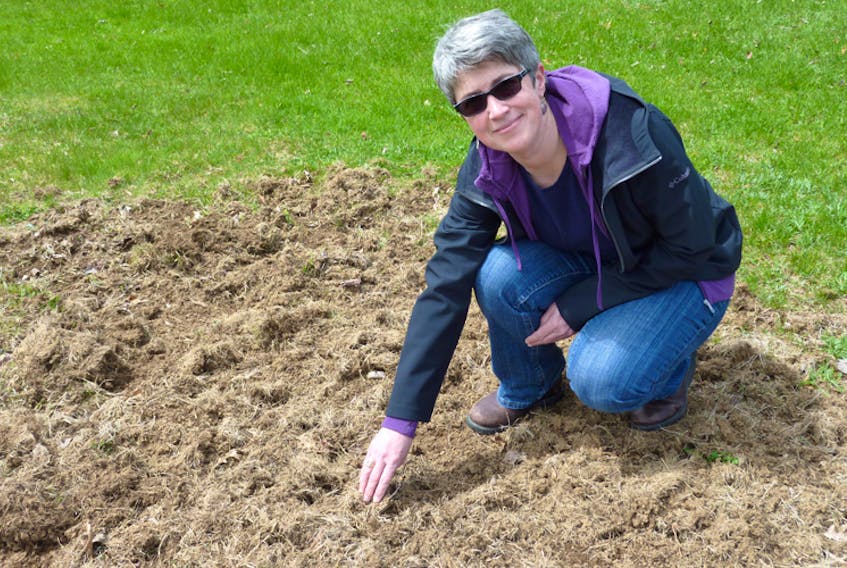The crows ravaging lawns on the South Shore are not as deadly as the crows that terrorized residents of Bodega Bay in the 1962 Alfred Hitchcock horror film The Birds, but they are troublesome nonetheless.
The crows have been tearing up the dead turf in search of white grubs, and the resulting damage has left the lawns on many homes, businesses and parks looking as though a farmer had just plowed the ground, prompting owners to consider their options - many of them costly.
“I grew up on a farm but I have never seen crows causing so much damage so quickly,” said Shelly Owen of Dayspring.
“As I watched from the window, the crows held pieces of turf in their beaks, flipped them over, then went on to the next piece. They overturned a large portion of our front lawn pretty quickly."
She's both shocked and dismayed by the destruction exacted on her property.
“It’s really annoying, but it’s nature. Crows are intelligent creatures and they will find a way to come back and finish the job,” she adds.
Owen, a nurse at Fishermen’s Memorial Hospital in Lunenburg, said she and her husband have yet to consider their options, but her preference is keeping the damaged part of their lawn as a non-grass area, perhaps spreading out decorative crushed stone in place of grass.
Many homeowners along Glen Allan Drive and its side streets in a newer part of Bridgewater have opted for various types of stone as ground covers, adding visual interest through the placement of statuary, large feature rocks, hardy ornamental grasses and shrubs, and potted plants.
Inundated with calls
Nature’s Reflections Landscaping owner Ben Floyd of Upper LaHave is well aware of the damage that crows, raccoons, and skunks can do when they are searching for white grubs, a favourite food.
Floyd easily rolled back a foot of dead turf on a lawn to reveal 10 white grubs.
“Imagine how many grubs live under this entire lawn,” he said. “The grubs have been feasting on grassroots all winter, killing the grass, so it’s easier for the opportunistic crows to find them.”
Lately, Floyd’s office has been inundated with calls from worried people enquiring about solutions to the problem.
“Many properties have been impacted this year, and owners are looking for help,” he said.
Public spaces, too, have suffered damage. Municipality of the District of Lunenburg recreation director Trudy Payne said one of three ball fields at the Municipal Activity and Recreation Complex in Dayspring has been deemed unsafe and is closed for the season, while the other two diamonds require repair.
“Repairs will be completed on fields one and three in time for the softball season, and teams affected by the closure of field two are looking for other ball fields to play their games on this year,” said Payne.

A solution?
It’s been about 20 years since chemical pesticides have been banned for consumer use in Nova Scotia, and the problem with grubs and other annoying and damaging bugs, such as chinch bugs, has worsened.
There is, however, a readily available, environmentally safe and proven remedy – nematodes.
Nematodes are aggressive, microscopic, worm-like organisms that search out and destroy grub larvae.
Moist soil drives the white grubs up near the surface, where the nematodes will find them, penetrate their bodies, and infect them with bacteria that kills them, usually within a few days.
Nematodes occur naturally in soil, but not in sufficient numbers to effectively control grub infestations, so packages of them are available at garden centres - some packages containing 50 million tiny creatures.
Emily Tregunno of Halifax Seed said more than 500 customers are on a waiting list for nematodes.
“Grubs are a serious problem. Chemical pesticides have not been options for consumers for many years, and biological remedies are trying to catch up. It’s shifting people’s attitudes from dealing with a problem they have to fix to considering preventative measures,” said Tregunno.
Proper soil maintenance, she said, is key. That includes applying fertilizers, lime, top dressing and over-seeding – "doing everything possible to ensure their lawns are as healthy as possible,” she said.
“The healthier the lawn, the thicker the grass, the less issues property owners are going to have. It’s also about making sure they use grass seed that’s right for their region.”
Tregunno said droughts have been problematic in Nova Scotia the past few years, keeping conditions hot and dry, which increases lawn problems exponentially.
Spraying lawns should be done via a dial-a-spray device that hooks up to a hose, she said. Cloudy, humid or rainy days are preferable. Nematodes apparently don’t like the cold, so spraying should be carried out only when the soil temperature reaches 14 degrees celsius or higher.
And to ensure the optimum survival rate of the nematodes, the lawn should be kept moist for about 10 days following spraying. She suggests consulting a local garden centre or lawn-care professional for more advice.









